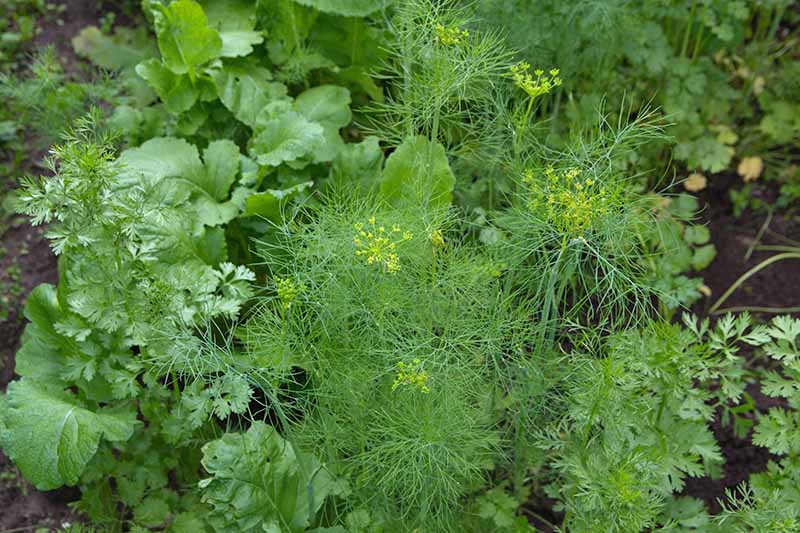
Gardening
Brassica Buddies: Companion Planting for a Bountiful Harvest Embark on a journey to enhance your brassica (cabbage, broccoli, cauliflower, kale, Brussels sprouts) harvest through the power of companion planting! Discover how strategic plant pairings can deter pests, improve soil health, and create a thriving garden ecosystem. This guide will provide specific, actionable tips to help you maximize your brassica yields, resulting in healthier, more abundant crops for your homestead table. !(https://auth.promptmarketer.com/storage/v1/object/public/generated-content/images/af6e4e54-5d3c-494e-9ed9-78723fad2f4e/retrieved_image_1_2025-09-19T20-01-24-602Z_lpai1rp45.jpg) ## Cabbage & Dill: A Moth-Repelling Match Cabbage moths are the bane of many a gardener's existence, their larvae capable of decimating entire cabbage crops. But fear not, fellow homesteaders! Dill is a natural repellent for these pesky moths. The aromatic oils in dill confuse the moths, preventing them from laying eggs on your precious cabbage. Plant dill directly amongst your cabbage plants, ensuring good airflow to prevent mildew. A good spacing guideline is to plant one dill plant for every three to four cabbage plants. Imagine a late spring afternoon, sun dappling through the dill fronds onto the robust, blue-green leaves of the cabbage – a beautiful and functional partnership. You can find excellent dill seeds at reputable seed suppliers like Baker Creek Heirloom Seeds: (https://www.rareseeds.com/) ## Broccoli & Chamomile: Attracting Beneficial Allies Aphids can weaken broccoli plants and transmit diseases, leaving you with stunted growth and disappointing yields. Luckily, nature provides a solution! Chamomile attracts hoverflies, whose larvae are voracious aphid predators. !(https://auth.promptmarketer.com/storage/v1/object/public/generated-content/images/af6e4e54-5d3c-494e-9ed9-78723fad2f4e/retrieved_image_2_2025-09-19T20-01-25-955Z_tvfx1gk0y.jpg) Plant chamomile near your broccoli to create a haven for these beneficial insects, ensuring your broccoli heads stay healthy and vibrant. Consider planting chamomile in pots near your broccoli patch or directly in the ground, spaced about 12-18 inches apart. Picture this: a close-up shot, bathed in golden hour light, showcasing a hoverfly larva feasting on an aphid on a broccoli leaf, with delicate chamomile flowers in the background – a miniature ecosystem at work. Consider sourcing your chamomile from a trusted herbal supplier like Mountain Rose Herbs: (https://mountainroseherbs.com/) ## Kale & Garlic: A Pungent Pest Deterrent Garlic's strong scent acts as a general pest deterrent, repelling various insects that might otherwise attack kale. From flea beetles to aphids, garlic can help protect your leafy greens from a multitude of pests. !(https://auth.promptmarketer.com/storage/v1/object/public/generated-content/images/af6e4e54-5d3c-494e-9ed9-78723fad2f4e/retrieved_image_3_2025-09-19T20-01-26-180Z_enugzxotc.jpg) Plant garlic strategically around your kale patch to safeguard your harvest. You can plant individual garlic cloves directly into the soil in the fall for a spring harvest, or plant them in the spring for a summer harvest. Emphasize the deep green hues of kale contrasted with the papery white of garlic bulbs just peeking from the soil – a visually appealing and mutually beneficial arrangement. ## Cauliflower & Thyme: Battling Cabbage White Butterflies Cabbage white butterflies are notorious for laying eggs that hatch into caterpillars that devour cauliflower leaves. Thyme, with its potent aroma, is an effective repellent against these unwelcome visitors. The strong scent of thyme masks the scent of cauliflower, making it less attractive to the butterflies. !(https://auth.promptmarketer.com/storage/v1/object/public/generated-content/images/af6e4e54-5d3c-494e-9ed9-78723fad2f4e/retrieved_image_4_2025-09-19T20-01-26-430Z_gygvajoyb.webp) Plant thyme near your cauliflower to protect it from these destructive pests. Creeping thyme works well as a ground cover around cauliflower, releasing its aroma as you walk by. The image should feature textured cauliflower heads next to woody thyme stems, backlit by the setting sun – a testament to the beauty of natural pest control. ## Brussels Sprouts & Rosemary: Cabbage White Butterfly Deterrent Similar to thyme, the strong aroma of rosemary also deters Cabbage White Butterflies. This allows the Brussels Sprouts to thrive without infestation, leading to a healthier and more abundant crop. !(https://auth.promptmarketer.com/storage/v1/object/public/generated-content/images/af6e4e54-5d3c-494e-9ed9-78723fad2f4e/retrieved_image_5_2025-09-19T20-01-27-501Z_0bwe7inp8.jpg) Plant rosemary around the Brussel Sprouts to provide the protection and encourage a healthy harvest. Rosemary is a perennial shrub, offering year-round protection to your Brussels sprouts. Be sure to consider the mature size of the rosemary bush when planting to avoid overcrowding. ## Additional Companion Planting Tips for Brassicas Beyond these key pairings, consider these additional tips to further enhance your brassica garden: * Nasturtiums: These vibrant flowers act as a trap crop, attracting aphids away from your brassicas. !(https://auth.promptmarketer.com/storage/v1/object/public/generated-content/images/af6e4e54-5d3c-494e-9ed9-78723fad2f4e/retrieved_image_6_2025-09-19T20-01-27-812Z_hkb0v4qx3.jpg) * Marigolds: Similar to garlic, marigolds possess a strong scent that deters a variety of pests, including nematodes and cabbage white butterflies. * Mint: Planting mint near your brassicas can help repel flea beetles. However, be sure to plant mint in containers to prevent it from spreading aggressively. * Radishes: These fast-growing root vegetables can help break up the soil and deter root maggots. !(https://auth.promptmarketer.com/storage/v1/object/public/generated-content/images/af6e4e54-5d3c-494e-9ed9-78723fad2f4e/retrieved_image_7_2025-09-19T20-01-28-061Z_7fouqydpd.png) ## Addressing Potential Challenges While companion planting offers numerous benefits, it's essential to be aware of potential challenges: * Nitrogen Imbalance: Brassicas are heavy feeders, requiring ample nitrogen to thrive. Avoid planting them too close to other heavy feeders like corn, as they will compete for nitrogen in the soil. Amend your soil with compost or a nitrogen-rich fertilizer like blood meal if necessary. * Allelopathic Effects: Avoid planting rue near brassicas as it can inhibit their growth due to its allelopathic properties. !(https://auth.promptmarketer.com/storage/v1/object/public/generated-content/images/af6e4e54-5d3c-494e-9ed9-78723fad2f4e/retrieved_image_8_2025-09-19T20-01-28-543Z_vnj9tmym0.jpg) ## Crop Rotation Implement crop rotation for optimal soil health. Avoid planting brassicas in the same location year after year to prevent the buildup of soilborne diseases and pests. A four-year rotation is generally recommended, alternating brassicas with legumes, root vegetables, and other plant families. !(https://auth.promptmarketer.com/storage/v1/object/public/generated-content/images/af6e4e54-5d3c-494e-9ed9-78723fad2f4e/retrieved_image_9_2025-09-19T20-01-28-837Z_ggr3ywoz0.jpg) ## Conclusion With careful planning and these companion planting strategies, you can create a vibrant, pest-resistant brassica garden that provides a bountiful harvest for your table. Embrace the power of natural partnerships and enjoy the fruits (or rather, vegetables!) of your labor. Happy gardening, fellow homesteaders!
Related Topics
bhh auto-generated brassica buddies companion